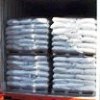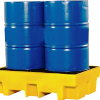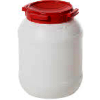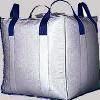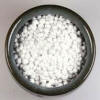Calcium Chloride BP IP USP ACS Analytical Reagent FCC Food Grade Manufacturers Suppliers India
Anmol Chemicals are manufacturers of Specialty Chemicals and Pharmaceutical Excipients, in India. Anmol Chemicals Group has manufacturing facilities spread across India, representatives in Houston Chicago USA and toll manufacturers in China. We make IP, BP, USP, Ph Eur, FCC or Food Grade, ACS, AR or Analytical Reagent Grade, LR or Laboratory Reagent Grade and Pure Grades of various chemicals. All our items are analyzed to meet the required standards.
Our manufacturing facility is FDA GMP approved and ISO-9001, ISO 14000, OHSAS 18000, ISO 22000, FSSAI HACCP certified. We are offering products manufactured as per Kosher and Halal approved method. We are pre-registered with "Reach" for export to European countries.
CAS No.: 10043-52-4
Molecular Weight: 110.98
Chemical Formula: CaCl2
Calcium Chloride USP
Calcium Chloride, Dihydrate. USP
CaCl2·2H2O 147.01
Assay— Calcium Chloride contains an amount of CaCl2 equivalent to not less than 99.0 percent and not more than 107.0 percent of CaCl2·2H2O.
Packaging and storage— Preserve in tight containers.
Labeling— Where Calcium Chloride is intended for use in hem dialysis, it is so labeled.
Identification— A solution (1 in 10) responds to the tests for Calcium and for Chloride.
pH: between 4.5 and 9.2, in a solution (1 in 20).
Aluminum (where it is labeled as intended for use in hem dialysis)— the limit is 1 4g per g.
Iron, aluminum, and phosphate— To a solution (1 in 20) add 2 drops of 3 N hydrochloric acid and 1 drop of phenolphthalein TS. Then add ammonium chloride–ammonium
hydroxide TS, drop wise, until the solution is faintly pink, add 2 drops in excess, and heat the liquid to boiling: no turbidity or precipitate is produced.
Heavy metals— the limit is 0.001%.
Limit of magnesium and alkali salts— Dissolve 1 g in about 50 mL of water, add 500 mg of ammonium chloride, and proceed as directed in the test for Limit of
magnesium and alkali salts under Calcium Carbonate, beginning with “heat the solution, and boil for 1 minute”: the weight of the residue does not exceed 5 mg (1.0%).
Organic volatile impurities meets the requirements.
Calcium Chloride BP Dihydrate Specifications
Calcium Chloride BP Dihydrate
CaCl2,2H2O
DEFINITION
Content
97.0 per cent to 103.0 per cent of CaCl2,2H2O.
CHARACTERS
Appearance
White or almost white, crystalline powder, hygroscopic.
Solubility
Freely soluble in water, soluble in ethanol (96 per cent).
IDENTIFICATION
Solution S (see Tests) gives reaction of chlorides.
It gives the reactions of calcium.
It complies with the limits of the assay.
TESTS
Solution S
Dissolve 10.0 g in carbon dioxide-free water prepared from distilled water and dilute to 100 ml with the same solvent.
Appearance of solution: Solution S is clear and not more intensely
colored than reference solution.
Acidity or alkalinity: To 10 ml of freshly prepared solution S add 0.1 ml of phenolphthalein solution. If the solution is red, not more than 0.2 ml of 0.01 M
hydrochloric acid is required to discharge the color and if the solution is
colorless, not more than 0.2 ml of 0.01 M sodium hydroxide is required to turn it red.
Sulphates: Maximum 300 ppm.
Aluminium: To 10 ml of solution S add 2 ml of ammonium chloride solution R and 1 ml of dilute ammonia and boil the solution. No turbidity or
precipitate is formed.
If intended for use in the manufacture of dialysis solutions, the above test is replaced by the test for
Aluminium maximum 1 ppm.
Barium: To 10 ml of solution S add 1 ml of calcium Sulphate solution R. After at least 15 min, any opalescence in the solution is not more intense
than that in a mixture of 1 ml of distilled water and 10 ml of solution S.
Iron: Maximum 10 ppm, determined on solution S.
Magnesium and alkali metals: Maximum 0.5 per cent.
Heavy metals: Maximum 20 ppm.
Calcium Chloride Hexahydrate BP Specifications
Calcium Chloride BP Hexahydrate
CaCl2,6H2O
DEFINITION
Content
97.0 per cent to 103.0 per cent of CaCl2,6H2O.
CHARACTERS
Appearance
White or almost white, crystalline mass or colorless crystals.
Solubility
Very soluble in water, freely soluble in ethanol (96 per cent).
It solidifies at about 29C.
IDENTIFICATION
Solution S (see Tests) gives reaction of chlorides.
It gives the reactions of calcium.
It complies with the limits of the assay.
TESTS
Solution S
Dissolve 15.0 g in carbon dioxide-free water prepared from distilled water R and dilute to 100 ml with the same solvent.
Appearance of solution: Solution S is clear and not more intensely
colored than reference solution.
Acidity or alkalinity: To 10 ml of freshly prepared solution S add 0.1 ml of phenolphthalein solution. If the solution is red, not more than 0.2 ml of 0.01 M
hydrochloric acid is required to discharge the color and if the solution is
colorless, not more than 0.2 ml of 0.01 M sodium hydroxide is required to turn it red.
Sulphates: Maximum 200 ppm.
Aluminium: To 10 ml of solution S add 2 ml of ammonium chloride solution R and 1 ml of dilute ammonia R1 . Heat to boiling. No turbidity or precipitate
is formed. If intended for use in the manufacture of dialysis solutions, the above test is replaced by the test for
Aluminium : maximum 1 ppm.
Barium: To 10 ml of solution S add 1 ml of calcium Sulphate solution. After at least 15 min, any opalescence in the solution is not more intense than
that in a mixture of 1 ml of distilled water and 10 ml of solution S.
Iron: Maximum 7 ppm, determined on solution S.
Magnesium and alkali metals: Maximum 0.3 per cent.
Heavy metals Maximum 15 ppm.
Calcium Chloride Injection as per USP Specifications
Calcium Chloride
Calcium Chloride Injection is a sterile solution of Calcium Chloride in Water for Injection. It contains not less than 95.0 percent and not more than 105.0 percent of the labeled amount of CaCl2·2H2O.
Packaging and storage— Preserve in single-dose containers, preferably of Type I glass.
Identification— It responds to the tests for Calcium and Chloride.
Bacterial end toxins— It contains not more than 0.2 USP End toxin Unit per mg of calcium chloride.
pH: between 5.5 and 7.5 in the undiluted Injection, except where the concentration is greater than 1 in 20, in which case this range applies to the Injection
diluted with water to yield a concentration of 1 in 20.
Particulate matter: meets the requirements for small-volume injections.
Other requirements— It meets the requirements under Injections 1.
Calcium Chloride FCC US Food Chemical Codex
CaCl2 Formula wt, anhydrous 110.98
CaCl2·2H2O Formula wt, dihydrate 147.01
Calcium Chloride
DESCRIPTION
Calcium Chloride occurs as white, hard fragments, granules, or powder. It is anhydrous or contains two molecules of water of hydration. It is deliquescent.
It is soluble in water and slightly soluble in alcohol. The pH of a 1:20 aqueous solution is between 4.5 and 11.0.
Function Firming agent.
REQUIREMENTS
Labeling: Indicate whether it is anhydrous or the dihydrate.
Identification: A 1:10 aqueous solution gives positive tests for Calcium and for Chloride.
Assay: Anhydrous: Not less than 93.0% and not more than 100.5% of CaCl2; Dihydrate: Not less than 99.0% and not more than 107.0% of CaCl2·2H2O.
Acid-Insoluble Matter Anhydrous: Not more than 0.02%; no particles per kilogram of sample greater than 2 mm in any dimension.
Arsenic: Not more than 3 mg/kg.
Fluoride: Not more than 0.004%.
Lead: Not more than 5 mg/kg.
Magnesium and Alkali Salts Anhydrous: Not more than 5.0%; Dihydrate: Not more than 4.0%.
Calcium Chloride Solution FCC Food Grade; US Food Chemical Codex
Calcium Chloride
DESCRIPTION
Calcium Chloride Solution occurs as a clear to slightly turbid, colorless or slightly colored liquid at room temperature. It is normally available in a concentration
range of about 35% to 45% of CaCl2.
Function: Sequestrant; firming agent.
REQUIREMENTS
Identification: When diluted to a concentration of about 1:10 (CaCl2 basis), a sample gives positive tests for Calcium and for Chloride.
Assay: Not less than 90.0% and not more than 110.0%, by weight, of the labeled amount of calcium chloride, expressed as CaCl2.
Alkalinity [as Ca(OH)2]: Not more than 0.3%.
Fluoride: Not more than 0.004%, calculated on the amount of CaCl2 as determined in the Assay.
Lead: Not more than 4 mg/kg, calculated on the amount of CaCl2 as determined in the Assay.
Magnesium and Alkali Salts: Not more than 5.0%, calculated on the amount of Calcium Chloride as determined in the Assay.
Calcium Chloride Dihydrate ACS Analytical Reagent
CaCl2 . 2H2O
Formula Wt 147.01
CAS Number 10035-04-8
Calcium Chloride
REQUIREMENTS
Assay: 99.0-105.0% CaCl2 - 2H2O
pH of a 5% solution: 4.5-8.5 at 25C
MAXIMUM ALLOWABLE
Insoluble matter: 0.01%
Oxidizing substances (as NO3): 0.003%
Sulfate (SO4): 0.01%
Ammonium (NH4): 0.005%
Barium (Ba): 0.005%
Heavy metals (as Pb): 5 ppm
Iron (Fe): 0.001%
Magnesium (Mg): 0.005%
Potassium (K): 0.01%
Sodium (Na): 0.02%
Strontium (Sr): 0.1%
Calcium Chloride Desiccant
CaCl2
Formula Wt 110.98
CAS Number 10043-52-4
REQUIREMENTS
Assay: 96.0% CaCl2
MAXIMUM ALLOWABLE
Titrable base: 0.006 meq/g

Manufacturers
ANMOL CHEMICALS
S-8, SARIFA MANSION, 2ND PRINCIPAL SHAIKH HASAN MARG, MUMBAI 400009, INDIA
TEL: (OFF) 91-22-23726950, 23774610, 23723564. FAX: 91-22-23728264
e-mail: info@anmol.org
Copyright and Usual Disclaimer is Applicable
Exporters to USA, UAE, Europe, South Africa, Tanzania, Kenya, Egypt, Turkey, Nigeria, Uganda, Brazil, Chile, Argentina, Dubai etc.
Representatives in New York, Houston - Texas, Chicago - Illinois, Los Angeles.
Fast Selling IP BP USP ACS FCC Food Grades of Chemicals by Anmol Chemicals
Aluminum Chloride ---------- Ammonium Sulfate ----- Ammonium Persulfate
Aluminum Potassium Sulfate - Ammonium Chloride ---- Ammonium Bicarbonate
Ammonium Carbonate --------- Benzyl Alcohol ------- Boric Acid
Benzoic Acid --------------- Borax; Sodium Borate - Calcium Chloride
Calcium Hydroxide ---------- Calcium Acetate ------ Calcium Butyrate
Calcium Lactobionate ------- Calcium Levulinate --- Calcium Saccharate
Carbamide Peroxide --------- Citric Acid ---------- Calcium Phosphate
Calcium Oxide -------------- Calcium Sulfate ------ Chromic Chloride
Cupric Chloride ------------
Ferric Chloride ------------ Ferric Nitrate ------- Fumaric Acid
Gentian Violet ------------- Glacial Acetic Acid
Lactobionic Acid ----------- Magnesium Butyrate
Magnesium Oxide ------------ Magnesium Chloride --- Magnesium Sulfate
Malic Acid ----------------- Maleic Acid ---------- Manganese Chloride
Manganese Sulfate ---------- Methylene Blue ------- Oleic Acid
Octyldodecanol -------------
Propylene Carbonate -------- Potassium Acetate ---- Potassium Carbonate
Potassium Hydroxide -------- Potassium Chloride --- Potassium Phosphate
Potassium Bitartrate ------- Propylene Carbonate -- Selenious acid
Sodium Molybdate ----------- Sodium Perborate ----- Sodium Phosphate
Sodium Propionate ---------- Sodium Acetate ------- Sodium Bicarbonate
Sodium Hydroxide ----------- Sodium Chloride ------ Sodium Thiosulfate
Sodium Selenite ------------ Urea ----------------- Zinc Chloride
Other Best Selling Products
Ammonium Bromide ----------- Ammonium Phosphate --- Barium Chloride
Butylated Hydroxyanisole --- Butylated Hydroxytoluene
Calcium Nitrate Nitrite ---- Calcium Propionate --- Copper Sulfate
Ceric Ammonium Nitrate ----- Cinnamaldehyde ------- Isatoic Anhydride
Directly Compressible Calcium Carbonate ----------- Encapsulated Citric Acid
Encapsulated Fumaric Acid -- Encapsulated Sodium Bicarbonate -
Encapsulated Sorbic Acid
Potassium Bromide ---------- Potassium Iodide ----- Potassium Nitrate Nitrite
Sodium Bromate ------------- Skatole -------------- Sodium Butyrate
Sodium Nitrite & Nitrate --- Sodium Bromide ------- Sodium Diacetate
Sodium Formaldehyde Bisulfite Strontium Chloride -- Stannous Chloride
TBHQ Tertiary Butylhydroquinone







